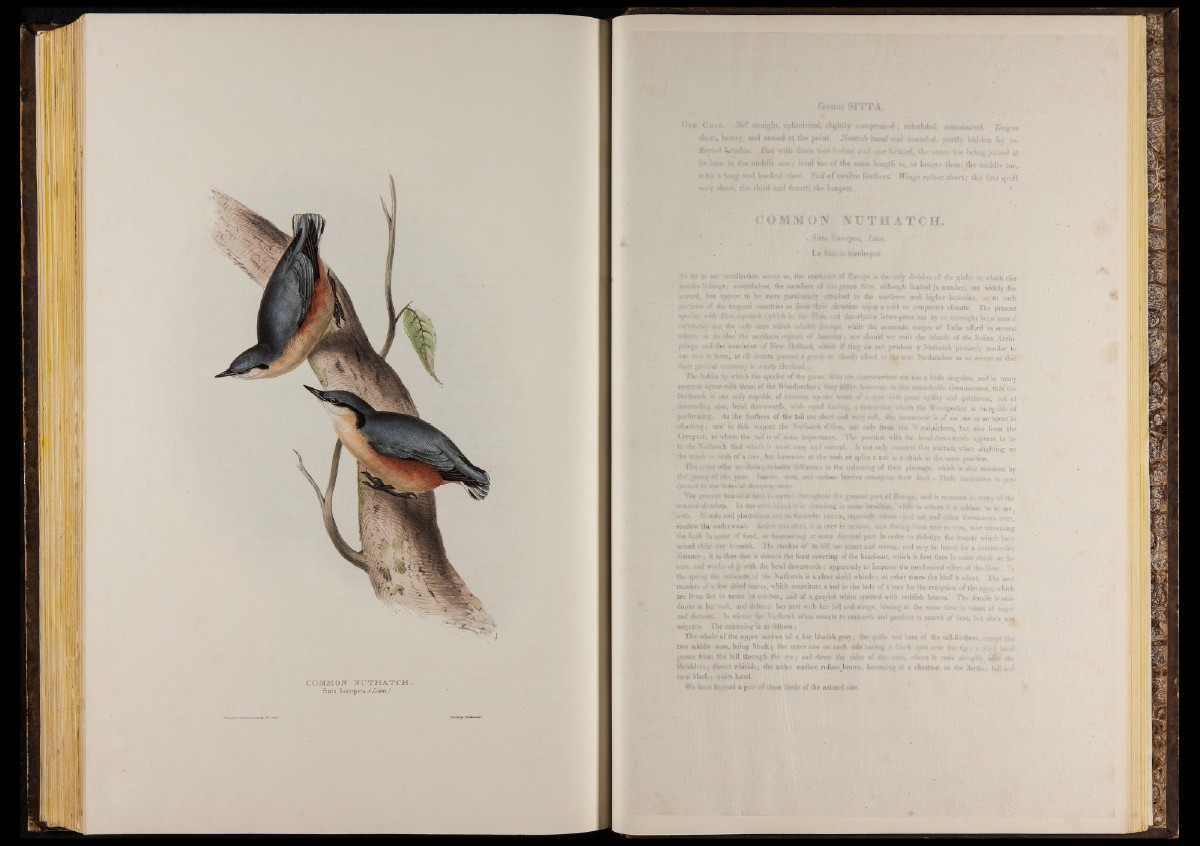
COMMOJST J SU T H A T C H |
Sitta Etiropea; (Lvnruj
ITTA.
iGSiQUiftte«. longue
iftrtïy îiïitden b y rebîi.
Cjïadl. B i ll straight, cylindrical, .slightly compressed ; subuk
abort, horny, and armed at the point, N o s tr ih basal and fouo<
its base to the imddle one 5 httid toe o f the same laiigtff a*,, or longer tfcag, thé middle
with a b>ag and hooked daw. 3hil of tw d v e feathers. Wing# rather short ; tile first
very abort, the. thihd and fourth th e longest..
!OMM ON S UT H ATC H.
• OlÎfil
h a i
ngs nevertheless, the member# ot
: appear to be more partkuhudy
the tropical countries as from sbe
do also the 1
1 the confiner
:ra! 1 fical..
, fidrope is the only division oi the globe to which this
fee gyohs Sitta, although limited ¿11 number, are widely dis-
twehtid to the northern and higher latitudes, o r to such
ik-i'iition enjoy a ookl or temperate climate. The present
'.ud •descriptive letter-press has by aw oversight been named
•ope, while the mountain ranges of India afford iis several
ijr«» i nor should we omit the islands of the Indian Arelii-
itfc if they do not produce a Nuthatch precisely similar, to
¡0 closely allied, to the true Nuthatches as to assure us that
'Fiie habii bfcjh the species of the gemis .AS#« a
respects agnte with those o f the Woodpecker; they to*
jSiuiiiatcb is not only capable of rnnning up the tftiti
deweadic-g also, head downwards, with equal feci Iky
performing. As the feathers of the tail are short >nd
climbing; aït'd in this respect the Nuthatch d; tiers,
Creepers, to whom the- tail is of main importance. *1
to the Nuthatch that which is most easy and natural,
the trank ht hmb of a tree, bat hammers at the bark <
S f e !i S 2 cdfer ttftdWnirawfe&l* diffmoee in the .
%tta at* chnflracterijseji are b e ta little singular, anffin many
icy awake. hotov.'tiTv in this remarkable circumstance, th&t the
c 'trunk iif a tfi)«'- wetfe great ugifity and quietness, but of
th* Woodpecker is incapable'of
of 1 agent in
¡ot only trorn the woodpeckers, but also from the
ie position with the head downwards appears to. be
It not only: assumes this attitude, when alighting "on
1 splits a nut in a chink in the same position.
''y^St^AdistyiotB. • . In Ont Awk) 1 • ' -kndtoftA! W’id
•with. . Wood» and plantiUaHHi «ro its feuo»riie Iwiuuts, «
shadow the underwood. A<-->>- fllert,- it is ever it n
mg
the hark in quest of food, or litaeOHwring at some dst’f.’.
! pari in Ord
to dislodge the insects which
mined thftb* way beneath.' Tlw: strokes of *M- lull we «u
tand strong,
nd may be heard for a coifsid*
distance; k. m, iiiu.s that it shivers the hurt! covering of 1
h it first fixes in some chink <
sure, and w o rt.- at &;■ with tp e head downwards 5 apparently to
the spring «he cidbtmt«, ok the Nuthatch is a clear shrill whistle; at other times the bird is silent. The nest
consists <•) few .d'rWi ietw«:.*, which constitute a bed in the bole of a tree for the reception of the e«*«*s, whicl:
'her, apd of a greyish white «potted with reddish brown. The female is assi-
A her nest with lie«* lull and wings, hissing ai- the some time in token o f atigef
Nwiihatch often resorts to orciMrds ahd^wienVin search of food, but does n*|
| o f a fc.k
are.Fri'm five to
duous in her t-w
and distress. In winter fjl
migrate. The colouring i
The whole o f the upper sitrfecp o f a fine blueish ggey; the epulis
two middle ones, being black; fik; cuter one on cc'-h side having
passes from -the bill through the eve; and down' the sides of .nh,*
ishoukl-rs; thnm whitish; tlie under surface rufous?brown, becouai
tarsi black; kkStfM hazel.
We have j%wml a pair of these birds- of the natural size.
the tail-feathers,
tnear the tin ? a i
; chestnut ou the Han